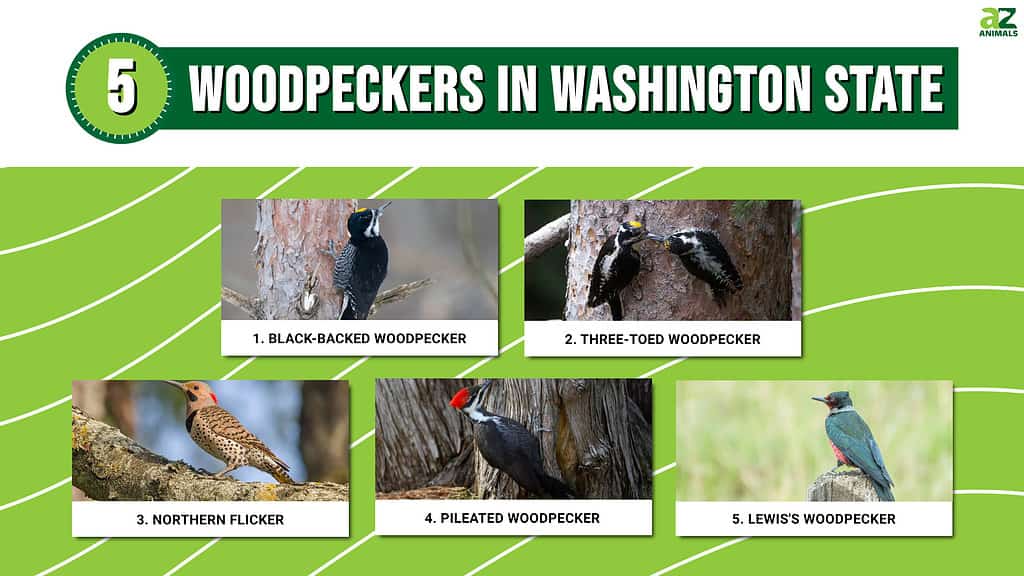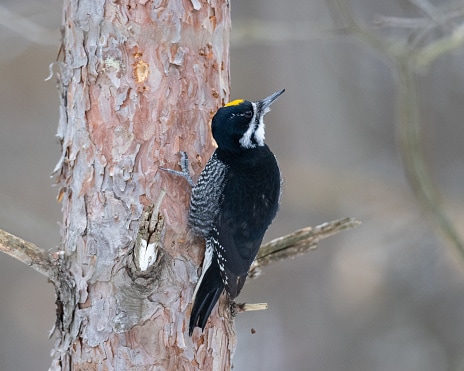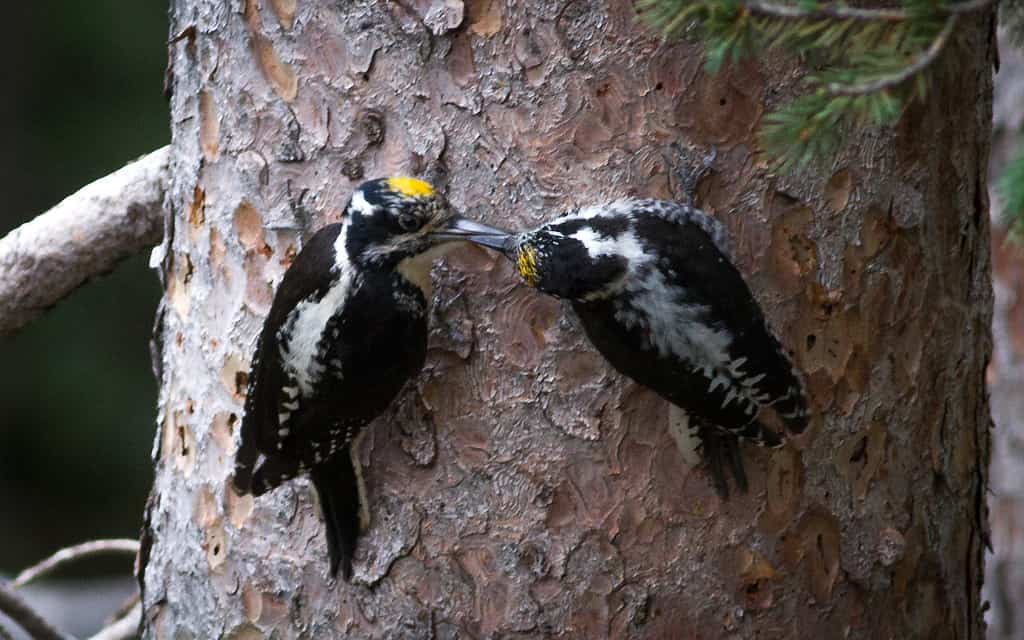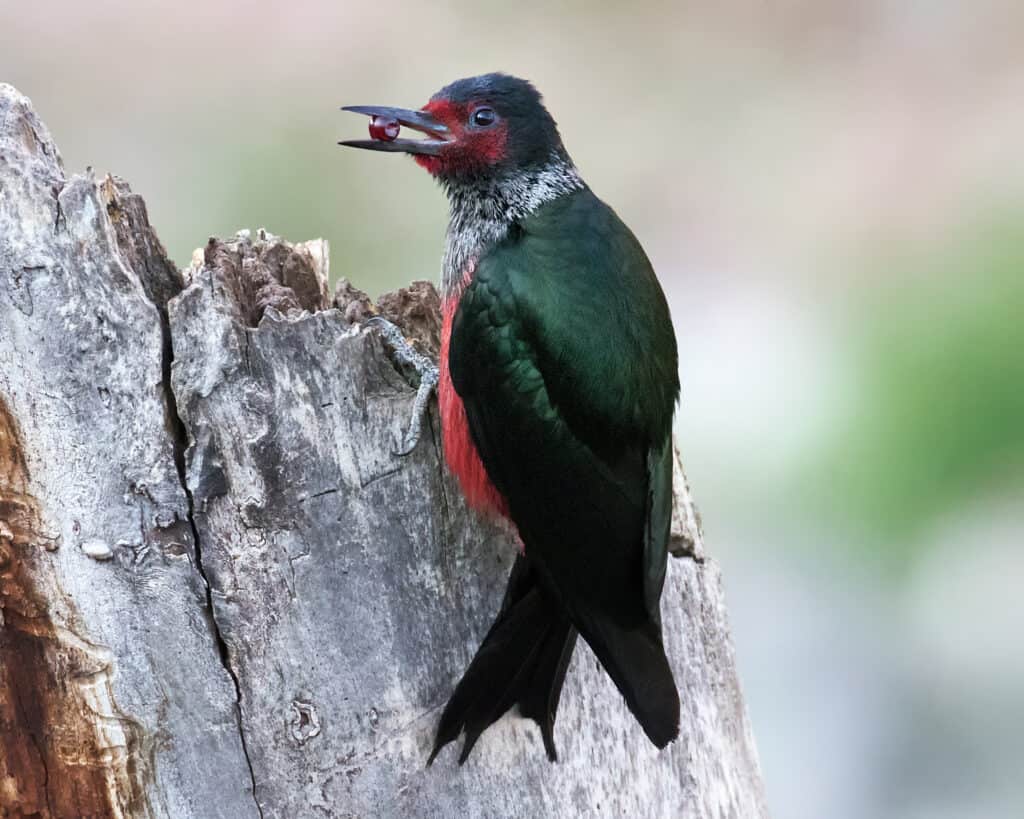
Washington is home to several species of woodpeckers that take up residence all across the state. They are a colorful and varied bunch that live among the many forest ecosystems of the Pacific Northwest. Some are a common sight, residing in Washington year-round, while others venture into the state only at the extent of their range. Others still are in decline, facing habitat loss and competition from other bird species, and appear only infrequently.
In this article, we’ll highlight five interesting and beautiful species of woodpeckers that call Washington their home. We’ll talk about where you can find them, the types of trees they nest in, how to identify them, and more.
1. Black-backed Woodpecker (Picoides arcticus)
The black-backed woodpecker is an uncommon sight in Washington state. Also known as the arctic three-toed woodpecker, It makes its home across the boreal forests of the northern United States and Canada, appearing more commonly further north and east than Washington. If you’re looking to spot this uncommon bird in the state, you’ll have the best chances in the spring.
Beginning in April, these woodpeckers begin to excavate nests in the sapwood of dead-standing trees. There, the female lays three or four eggs which are cared for jointly by herself and her partner. The chicks that emerge from the eggs are underdeveloped at birth. With the continued joint care of the parents, however, the chicks reach their fledgling stage quickly at about three weeks of age.
The plumage of adult black-backed woodpeckers is primarily black. The head, wings, back, and rump are all black. Beginning at the throat and face and continuing down to the belly, the front of the bird is white with black bars along the flanks and white bars near the wing tips. The tip of the beak is jet black, with males exhibiting a golden-yellow crown atop their heads. Unlike most other species of woodpeckers, this species has only three toes. Adults of the species are medium-sized compared to other woodpeckers, averaging about 9 inches in overall length and weighing 2 to 3 ounces. Their wingspan averages 16 inches across.

Black-back woodpecker clinging to a red pine tree displaying its yellow crown patch
©gqxue/iStock via Getty Images
2. Three-toed Woodpecker (Picoides dorsalis)
The American three-toed woodpecker, belonging to the genus Picoides, is closely related to the black-backed woodpecker. Like the black-backed woodpecker, this species has three toes rather than four. Males of the species also have a golden-yellow crown. While the two species may appear quite similar, the American three-toed woodpecker stands apart due to its smaller size and the white bars and markings that appear down its back.
This woodpecker is also uncommon in the state of Washington but has an affinity for the conifer forests in and east of the Cascade Mountains. Hart’s Pass, Colockum Pass, Fields Spring State Park, and the Thunder Mountain burn are all great sites to seek out these birds throughout the year.
In the spring, the birds will excavate nests into the sides of dead-standing conifers. Most commonly, they will choose spruce, pine, fir, or tamarack. Sometimes, however, they will carve their nests into deciduous trees like aspens and willows. Nesting height can vary drastically but is usually between 5 and 15 feet above the ground. Some nests can appear as high up as 50 feet if the tree allows for it.
These birds feed primarily on insects that target trees and therefore appear more commonly after floods and forest fires. These events kill trees and weaken living ones, leaving them susceptible to infestation by wood-boring beetles. In addition to beetles and their larvae, the three-toed woodpecker will also feed on caterpillars, termites, ants, and available fruits. They will also feed opportunistically on tree sap from wounds created by other woodpecker species.

A pair of male American three-toed woodpeckers perched on the side of a large conifer. Note the yellow patches on the foreheads. Birds of this species will peel flakes of bark away from trees like this one in search of
insect
prey.
3. Northern Flicker (Colaptes auratus)
Unlike the three-toed species above, the northern flicker is a very common sight. They prefer open areas and happily make their homes along suburban streets, in parks, and in residential areas. The northern flicker also frequents grassland environments, forest edges, sagebrush, and dunes.
In the spring, members of this species will excavate nests into the sides of pines, cottonwoods, or willows, with the males doing most of the work. Usually, they will select dead trees. However, they may also target living trees that are in decline. Once the nest is ready, the female will lay between 5 and 8 eggs. The pair will then care jointly for the eggs until they hatch. After about three weeks, the babies will leave the nest and forage alongside their parents once they are able.
While they excavate nests into the sides of trees using their beaks, they behave differently from most woodpeckers in terms of feeding behavior. Rather than pecking away at a tree in search of wood-boring insects, these birds feed primarily on exposed insects. Ants are their primary interest. However, they will also readily eat termites, caterpillars, beetles, and most other insects. When available, they will also forage for various fruits and seeds.
These birds are also different from other North American woodpeckers in their coloration. While most other native woodpeckers are primarily black, white, and red, the northern flicker is primarily brown. There are two common forms of northern flicker that occur within the state. The red-shafted form is the most common and presents red-shafted flight feathers and tail feathers. Males display red moustaches behind their beaks while females have one that is light brown. The less common yellow-shafted form has yellow-shafted flight feathers and yellow feathers on the underside of the tail. They display characteristic red patches at the nape of the neck, just behind the head.

A male, yellow-shafted northern flicker. Note the brown-black mustache and yellow feathers beneath the wings and tail.
©Fiona M. Donnelly/Shutterstock.com
4. Pileated Woodpecker (Dryocopus pileatus)
The pileated woodpecker is the largest species of woodpecker in North America. Whereas many other woodpeckers reach sizes of around 8 or 10 inches in overall length, this species can grow to lengths of up to 19 inches from beak to tail.
In addition to its great size, the other features of the pileated woodpecker make it easy to identify. It is almost entirely black except for the distinct white stripes that run down the neck and face. During flight, white feathers become more apparent in the wing lining. Both sexes sport a bright red crest on the tops of their heads. While both males and females display the same markings overall, the two sexes are easily distinguished. Males have red moustache markings behind their beaks while females have black ones. Additionally, males present a longer crest than females.
The pileated woodpecker is a fairly common sight in Washington State year-round, though it appears more frequently in the western portion of the state. This species is not picky about the type or age of forest that it lives in. Though they appear more often in old-growth forests, they can live and breed in any forested environment that contains large trees.
If you’re looking to spot this beautiful woodpecker, check out Seward Park, Discovery Park, or Camp Long in Seattle, where they are known to breed annually. They are also frequent along the coast, in the Blue Mountains, and throughout the Puget Trough.

©FotoRequest/Shutterstock.com
A female pileated woodpecker perched on the side of a tree. Note the fiery red crest, the absence of a red mustache, and the characteristic white striping along the side of the head.
5. Lewis’s Woodpecker (Malanerpes lewis)
Lewis’s woodpecker is mid-sized, growing to about 10 inches in length. Like the northern flicker, this species presents a rather odd color scheme for a North American woodpecker. Its plumage is dark green and black along the head and back, turning pink to gray across the chest. The face is red and is framed by a collared neck that is speckled in red, black, and gray. Members of this species are monogamous and sometimes remain bonded with a single partner for many years.
These forest-dwelling woodpeckers prefer habitats that have fairly open canopies. They appear frequently along riversides with large cottonwoods, Ponderosa pine forests, and Garry oak stands. When nesting, they will choose a dead and decaying tree or snag — most commonly Ponderosa pine or cottonwood — and excavate a hole in the side. Somewhat oddly for a woodpecker, Lewis’s woodpecker hunts flying insects to source the majority of its food throughout the summer. In the fall, as insects become scarce, they will collect seeds, nuts, and berries and store them in caches that they create in trees. In the winter, some will move southward into California and Oregon. Those that don’t leave will usually overwinter further south in the state.
This species is an uncommon sight across Washington State, though it may be seen more frequently in the eastern portion during the summer. Recent trends appear to show that this species’ population is declining. Fire suppression tactics and harvesting and clearing of large trees and snags during forest management are the primary threats to this bird’s habitat. They are also under threat of displacement by European starlings, which compete with them for nesting sites.

Lewis’s Woodpecker perched on a stump with an acorn in its bill.
©rbrown10/Shutterstock.com
Summary of 5 Woodpeckers That Live in Washington State
| Woodpecker | Appearance | |
|---|---|---|
| 1 | Black-backed Woodpecker | Black head, rump, and back with white rings at throat – males have a yellow crown |
| 2 | Three-toed Woodpecker | Smaller and similar to the black-backed – this little woodpecker has a white strip down its back |
| 3 | Northern Flicker | Brown with dark spots and mustache marking, and red or yellow flight feathers |
| 4 | Pileated Woodpecker | Large black bird with white markings and red crest |
| 5 | Lewis’s Woodpecker | Dark green with white markings around neck and red face and neck |
Thank you for reading! Have some feedback for us? Contact the AZ Animals editorial team.








